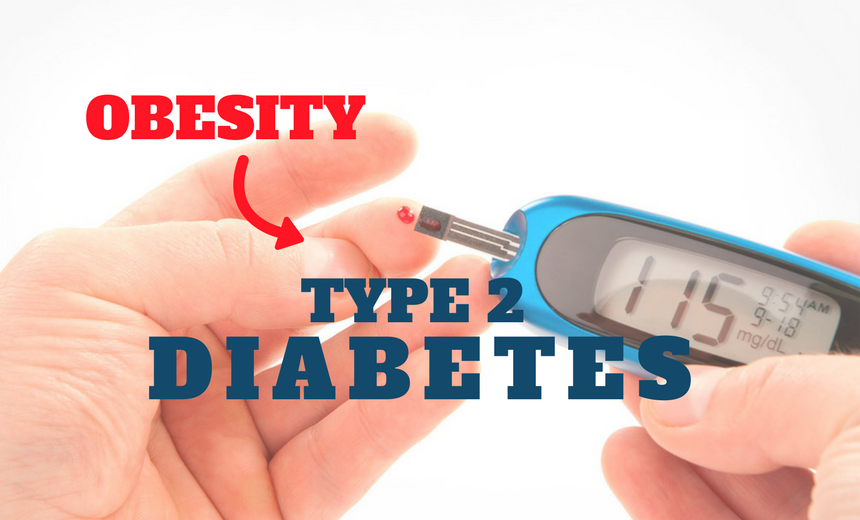Note: Obesity is not the sole risk factor for type 2 diabetes.
Type 2 diabetes is labelled as a lifestyle disease. This means a sedentary and inactive lifestyle can surely trigger blood glucose levels. Obesity increases your risk of developing diabetes, a disorder characterized by an excess of glucose (sugar) in your body. Obesity also speeds up the progression of diabetes.

What is Type 2 Diabetes?
Type 2 diabetes is a chronic medical disorder in which sugar, or glucose, levels in the blood rise. Insulin aids in the transport of glucose from the bloodstream to cells, where it is used for energy. However, in type 2 diabetes, your body’s cells are unable to respond to insulin as efficiently as they should. In the later stages of the disease, your body may not create enough insulin.
Complications of High Blood Glucose Levels
Complications of high blood sugar include:
- Risk of heart disease including stroke
- Nephropathy
- Neuropathy
- Retinopathy
- Erectile dysfunction in men
- Amputation
- Depression
How Is Obesity Linked With Type 2 Diabetes?
Excess weight can harm your health in a variety of ways, the most dangerous of which is type 2 diabetes. When a diabetic person gains weight, the cells in his or her body become less responsive to the insulin generated by the pancreas. Few studies suggest that fat cells are more insulin resistant than muscle cells.
Individuals with type 2 diabetes who exercise appear to have less severe insulin resistance because the exercising muscles utilize the extra sugar in the blood; hence, the body does not generate insulin and the sugar is not transferred to excess fat cells.
Individuals suffering from excess weight, particularly obesity, are more prone to developing type 2 diabetes as a result of their condition.
Obesity and morbid obesity significantly raise your risk of developing heart disease. It can also lead to certain types of cancer, sleep apnea, osteoarthritis, and other diseases.
Abdominal Obesity and Diabetes
Excess abdominal fat is referred to as central or abdominal obesity, and it is a particularly dangerous kind of obesity. It is common knowledge that if you are obese, you are more likely to acquire type 2 diabetes, especially if you have excess weight around your midsection (abdomen).
Abdominal obesity causes fat cells to emit ‘pro-inflammatory’ substances. This makes the body less sensitive to the insulin it produces by interfering with the function and ability of insulin-responsive cells to respond to insulin. This is also commonly known as “insulin resistance”, a common reason behind diabetes.
Other lifestyle factors that have been linked to increases in both diabetes and obesity include:
- Eating too many carbs
- Taking less sleep
- Inactive lifestyle
How Does Obesity Lead to Diabetes?
Glucose, the body’s principal source of energy, is found in several of the foods we eat. Some glucose is used right away after a meal, while the rest is stored inside cells for later use. Insulin is a hormone that controls the storage of glucose by putting it within the cells. The quantity of fat in the body appears to have an impact on how efficiently this process functions.
There is no single cause for this, although research suggests that fat may prevent insulin from delivering glucose to cells. The more fat in the body, the worse insulin performs and the more glucose accumulates in the blood. Diabetes is a condition in which blood glucose levels are abnormally high.

How is Type 2 Diabetes Detected in Obese Patients?
Type 2 diabetes is diagnosed the same way in all individuals, regardless of weight. You can also test your diabetes via a blood sugar testing machine. However, your doctor might suggest you some other ways, too:
- Fasting Blood Glucose Test
Refrain from eating or drinking for at least 8 hours prior to submitting your blood. Diabetes is diagnosed when your fasting blood glucose level is 126 mg/dL or greater.
- HbA1c Test
The HbA1c test is a blood glucose test that does not necessitate fasting or any other particular preparation. It provides an estimate of blood glucose levels for the previous two to three months and is expressed as a percentage.
You have diabetes if your A1C is 6.5 percent or greater.
Obesity and Type 2 Diabetes Prevention
Obesity-related diabetes can be prevented by losing weight. According to research, losing as little as 3% to 5% of your total body weight can enhance your physical health.
Exercise and food are the two basic strategies to reduce weight.
Being active makes your body more responsive to insulin (the hormone that permits cells in your body to utilise blood sugar for energy), which aids with diabetes management. Physical activity also aids in blood sugar regulation and reduces your chances of heart disease and nerve damage.
For diabetics, the American Diabetes Association advises to eat fewer refined carbohydrates and added sugars in favor of whole grains, legumes, vegetables, and fruit. Low-carbohydrate diets emphasize carbohydrate restriction with the belief that fewer carbohydrates are better.
